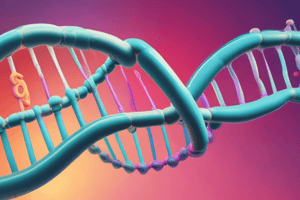Podcast
Questions and Answers
What is the term for the three-letter sequences in DNA that encode amino acids?
What is the term for the three-letter sequences in DNA that encode amino acids?
- Genes
- Trinucleotides
- Codons (correct)
- Triptides
How many possible codons exist in the genetic code?
How many possible codons exist in the genetic code?
- 16
- 128
- 64 (correct)
- 32
What happens when there are changes in specific nucleotide positions within codons?
What happens when there are changes in specific nucleotide positions within codons?
- Heritable differences (correct)
- Loss of DNA structure
- Increased genetic mutations
- Improved protein function
Which aspect of DNA determines the diversity observed in living organisms?
Which aspect of DNA determines the diversity observed in living organisms?
What is the primary role of codon sequences in DNA?
What is the primary role of codon sequences in DNA?
What are the four different nucleotides present in DNA?
What are the four different nucleotides present in DNA?
What holds the two strands of DNA together in a double helix structure?
What holds the two strands of DNA together in a double helix structure?
During DNA replication, what ensures complementarity between the two strands?
During DNA replication, what ensures complementarity between the two strands?
What is the term used to describe the process in which one old DNA strand and one new DNA strand are present in the final product of DNA replication?
What is the term used to describe the process in which one old DNA strand and one new DNA strand are present in the final product of DNA replication?
What does the genetic code determine with respect to the sequence of nucleotides in DNA?
What does the genetic code determine with respect to the sequence of nucleotides in DNA?
Flashcards are hidden until you start studying
Study Notes
Understanding the Molecular Basis of Inheritance
Inheritance, the passing down of traits from parents to their offspring, is a fundamental concept in biology. The molecular basis of inheritance is largely explained by the structure and function of DNA, the process of DNA replication, and the genetic code. Here, we delve deeper into these topics.
DNA Structure
Deoxyribonucleic acid (DNA) is a double-stranded molecule made up of four different nucleotides: adenine (A), thymine (T), guanine (G), and cytosine (C). Each nucleotide is connected to the next by hydrogen bonds, forming a ladder-like structure called the double helix. The base pairing rules are A with T and G with C, ensuring complementarity between the two strands. This structure allows for the efficient storage of genetic information in a compact form.
DNA Replication
During the process of DNA replication, the double helix unwinds, and each strand acts as a template for the synthesis of a new complementary strand. This process occurs during cell division, ensuring that each daughter cell receives a complete set of genetic information from its parent cell. DNA replication is semi-conservative, meaning that one old and one new strand are present in the final product.
Genetic Code
The genetic code is the set of rules that determines how the sequence of nucleotides in DNA determines the sequence of amino acids in proteins, which are essential for cell function. This code is written in three letters called codons, each consisting of three adjacent nucleotides. There are 64 possible codons (four bases raised to the power of three), which can encode twenty different amino acids, along with a start signal and a stop signal.
Codon sequences determine the structure and function of proteins, which carry out many biological processes in cells. Mutations or changes in the nucleotide sequence at specific positions within these codons can lead to heritable differences among individuals, sometimes resulting in variations in physical traits or susceptibility to diseases.
In summary, the molecular basis of inheritance revolves around the structure of DNA, the process of DNA replication, and the genetic code. These fundamental aspects enable the transmission of genetic information from generation to generation, shaping the diversity we observe in living organisms.
Studying That Suits You
Use AI to generate personalized quizzes and flashcards to suit your learning preferences.




